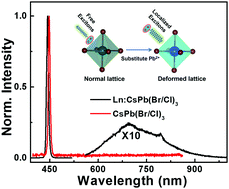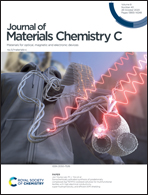Broadband emission in all-inorganic metal halide perovskites with intrinsic vacancies†
Abstract
Efficient broadband emission related to self-trapped excitons (STEs) in low-dimensional perovskites and double perovskite crystals has attracted great attention due to its potential applications in optoelectronics. However, the formation of STEs in three-dimensional (3D) all-inorganic perovskites (CsPbX3) is difficult. Here, through the doping of ytterbium (Yb3+) or erbium (Er3+) ions into CsPbX3 crystals, we observed broadband luminescence from STEs with a linewidth exceeding 200 nm and a Stokes shift of ∼1 eV. Theoretical concepts and experimental studies demonstrated that Pb2+ in perovskites could be replaced by impure ions. Also, the Pb2+ substitution defects and adjacent halide vacancies introduced defect states lying just below the conduction band minimum of perovskites. Strong electron–phonon coupling between trapped carriers and deformation of the [PbX6] cage reduced the energy gap of perovskites. Our study sheds new light on the permanent defects induced in extrinsic STEs in 3D inorganic perovskites. It also provides a clear microscopic picture of the underlying mechanism of formation of STEs.

- This article is part of the themed collection: Journal of Materials Chemistry C HOT Papers


 Please wait while we load your content...
Please wait while we load your content...